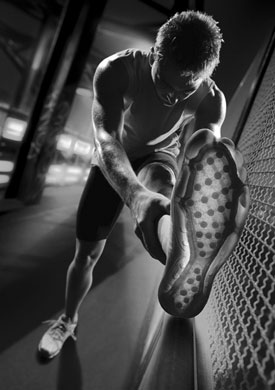Delayed onset of muscle soreness is something that many of those training experience. Regardless of whether you are a heavily trained athlete or a recreational exerciser just starting out, there will come a time when you’ll roll out of bed and notice you have a strange inability to walk. This is what is commonly referred to as DOMS.
As a result of this soreness, many people mistakenly begin to believe that it is a necessary factor to indicate you have had an effective workout. This is not the case, however, as DOMS can and will occur for numerous reasons such as exercise selection, nutritional intake prior to and after the exercise session, degree of training status, and the amount of rest given. Many treatment methods for DOMS have been established to help make this tender period lower in duration.
Recently a study was published by the School of Community Health and Sports Studies looking at the causes of DOMS and the most effective management protocol.
 Anti-inflammatory drugs have shown to have some positive impacts on recovery depending on when they are administered. Massage also can prove to be helpful however shows variable results that really depend on the type of massage given and who is administering it. Often thought to help but proven quite ineffective treatment methods include cryotherapy, stretching, homeopathy, as well as ultrasound or electrical current stimulators. Some people will attempt to use these but with very little success. Interestingly, and contrary to what most individuals would think, exercise proves to be one of the most effective ways of relieving DOMS. It’s important to note though that often with exercise, the pain may return later on the day, so while short-lived, it can make the natural recovery process that much easier.
Anti-inflammatory drugs have shown to have some positive impacts on recovery depending on when they are administered. Massage also can prove to be helpful however shows variable results that really depend on the type of massage given and who is administering it. Often thought to help but proven quite ineffective treatment methods include cryotherapy, stretching, homeopathy, as well as ultrasound or electrical current stimulators. Some people will attempt to use these but with very little success. Interestingly, and contrary to what most individuals would think, exercise proves to be one of the most effective ways of relieving DOMS. It’s important to note though that often with exercise, the pain may return later on the day, so while short-lived, it can make the natural recovery process that much easier.
Speeding Up Recovery
When using exercise as a means to help recover from DOMS, it’s encouraged to reduce the total intensity and length of the exercise for a couple of days following the original onset and those body parts that are least sore should be the primary ones focused on. You should also avoid introducing any new movement patterns during a recovery period of DOMS because often the soreness is most noticeable when new exercise is completed. So next time you find that you’re feeling pretty tender, don’t take that as a signal to completely back off exercise. Some lighter exercise can help with the recovery process and allow you to feel better. Just be sure you don’t try and push the tender muscles too hard or you may put yourself at risk for injury.
Written By: Shannon Clark
Reference:
Cheung, K., Hume, P., Maxwell, L. (2003). Delayed onset muscle soreness: treatment strategies and performance factors. Sports Medicine. 33(2):145-64.










